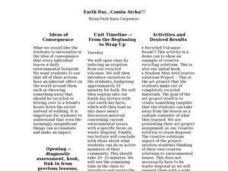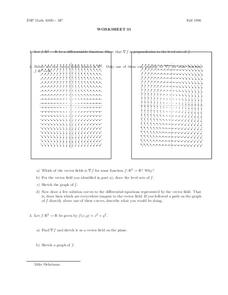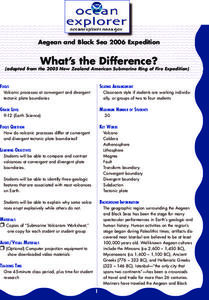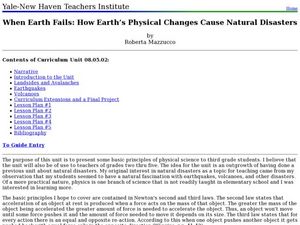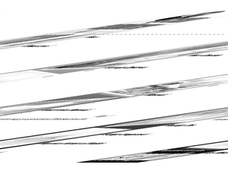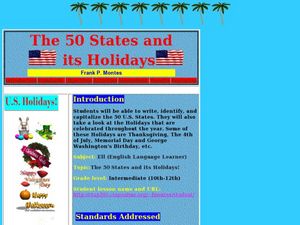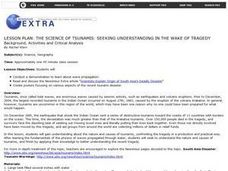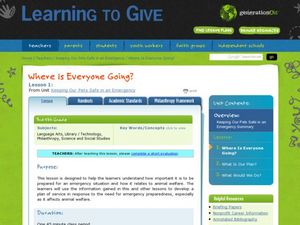Curated OER
Earth Egg
Students discuss plate tectonics and the layers of the earth's interior. They use eggs as models of the earth and answer questions regarding which part of the egg would represent which part of the earth.
Curated OER
Earth Day...Comin Atcha!!!
Students explore the idea of consequence that every individual leaves a daily environmental footprint. They read articles about creative solutions to solid waste issues and then create an artwork from household trash.
Curated OER
Worksheet 35
In this math worksheet, students analyze two vector fields. They tell which of the vector fields is the scaler field for the given function. Students draw solution curves to match the differential equations represented in the illustrations.
Curated OER
The Ruins of Pompeii: A Window into History
Sixth graders research the history of Pompeii and its destruction. Locate important geographical features of Rome. Gain insight into the past through archaeological interpretation. Synthesize historical information through imaginative...
Curated OER
Cruising the Mantle
Learners explore the plate boundaries of the earth. Through the use of video, internet and hands-on activities, students examine the types of plate boundaries. They create a model to illustrate the movement and interaction of the...
Curated OER
What's the Difference?
High schoolers investigate volcanic processes at convergent and divergent
tectonic plate boundaries. They read and analyze diagrams, complete a worksheet, and write an essay.
Curated OER
When Earth Fails: How Earth?s Physical Changes Cause Natural Disasters
Students examine natural disasters and some safety measures that should be followed. In this natural disaster lesson students write a narrative, and research safety procedures.
Curated OER
The Tell-Tale Plume
Students examine hydrothermal vents. In this ocean lesson, students identify changes in physical and chemical properties of sea water caused by hydrothermal vents.
Curated OER
Water in Alabama History
Students examine the role of water in Alabama's history. They discover the geographical regions of the state and how dams change Alabama's rivers.
Curated OER
SCRUMPTIOUS SOIL
Students engage in investigations that lead to the discovery that earth materials consist of rocks, soils, water, and air. They build models of soil profiles, using breakfast cereal and other edible materials. They observe how water...
Curated OER
Adverbs
Students encounter the various functions of using different types of adverbs. Students use various adverbs to describe how, where and when events happen. Students show examples of adverbs in various newspaper articles.
Curated OER
Geological Features: How Weathering & Erosion Help Create Landforms
Students explore how the Earth's surface changes resulting in geological features and landforms. They perform a read-a-loud on Thomas
Locker's Mountain Dance, complete a KWL chart, and create a
landform using plaster of paris.
Curated OER
Ecology and Evolution
Students identify the different taxonomic classifications of organisms. In this biology instructional activity, students create their own organisms and make some changes according to environmental conditions. They present their work in...
Curated OER
Life of an Island: From Mountain to Atoll
Students research the evolution of a volcanic island from origin to erosion. They determine the relative ages of the Northwestern Hawaiian Islands given their position in the archipelago.
Curated OER
Building a Better Sentence
Sentence construction is both a science and an art. This bare bones lesson ties an analysis of earth's geology to sentence formation. Although referenced as a major part of the activity, there are no links to the technology or resources...
Curated OER
The 50 States and its Holidays
Though the format of this ELL lesson is confusing (the standards listed are for plate tectonics, yet the objectives are for American geography and holidays), a teacher could glean some ideas from the main idea. Here, pupils complete a...
Curated OER
Jupiter's Moons
Students predict which of Jupiter's moons will be the "brightest" in infrared wavelengths. Using provided information, they rank the moos from brightes to faintest in infrared.
Curated OER
Excavation reveals a village buried by 1815 volcanic blast
Learners create a photo essay depicting how natural features have impacted their town. In this natural features lesson plan, students read about a volcanic blast, answer comprehension questions about it, and then discuss how natural...
Curated OER
The Science of Tsunamis: Seeking Understanding in the Wake of Tragedy
Students use Internet research, articles, discussion and models to explore the dynamics of a tsunami. They focus on the 2004 Asian Tsunami and create posters illustrating their understanding of this phenomenon.
Curated OER
Our Ever Changing Earth
First graders discover plate tectonics. They observe the forces of erosion. They observe the forces of weathering. They state three ways the earth changes. They record observations and make conclusions about their observations.
Curated OER
Enduring Influence: Rome, Greece, and Byzantium
Students explore ancient cultures. For this ancient history lesson, students view programs that depict the ancient Roman, Greek, and Byzantine cultures. Students consider how archaeologists, geologists, and scientists have uncovered the...
Curated OER
Modeling Plate Tectonics
Students investigate the four different ways tectonic plates interact at their boundaries. Using simple available materials, they create models to simulate these interactions present at plate boundaries.
Curated OER
The Physical Geography of Australia, Oceania, and Antarctica
Students access information from the United States Geological Survey's Web site This Dynamic Earth to research the Ring of Fire. They answer four questions and then apply what they have learned to create a bulletin board display.
Curated OER
Where is Everyone Going?
Learners conduct an experiment. In this emergency response lesson, students watch videos about hurricanes and discuss the difference between natural disasters and man-made disasters. Learners perform a hurricane demonstration and...

